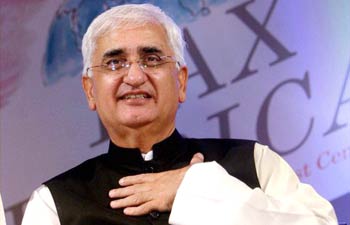
Lucknow, October 13: Despite denials of wrongdoing in a trust for disabled people that Union law minister Salman Khurshid and his wife operate, it now appears that there was a letter with the forged signature of a senior UP government official that allowed the Union ministry of social justice and empowerment to release the second tranche of funds in March 2011 — Rs 68 lakh — to the Zakir Hussain Memorial Trust. This was in addition to Rs 71 lakh that the trust got from the Union ministry also, allegedly, on the basis of forged letters in 2009-10.
Carrying the signature of a former special secretary of the department of disabled welfare, government of UP, the letter, dated March 24, 2011, said the state government had assessed, to its satisfaction, the work being done by the trust to help disabled people. Adding that the trust had, in 2009-10, distributed appliances to the disabled in the presence of "competent technical specialists" at specially organised camps in 17 districts of Uttar Pradesh, the letter also recommended the trust's name for further releases from the ministry. A copy of the letter is with TOI.
When TOI contacted the now retired bureaucrat, he confirmed, on condition of anonymity, that his signatures were forged. The officer also confirmed he retired from UP government services in January 2011, nearly three months before the letter was sent out in his name. Sources in the state government confirmed that a signed copy from the officer, saying his signature was forged, has been received. The same has also been forwarded to the office of chief minister Akhilesh Yadav as part of a probe into the operations of the trust.
India Against Corruption activist Arvind Kejriwal had alleged that in 2009-10, the trust had embezzled Rs 71 lakh of government funds earmarked for artificial limbs and crutches for disabled people by forging signatures of officials.
Though the mandatory "test report" - independent assessment of an NGO's work by the state government — was still under investigation, the ministry, on the basis of this forged letter, proceeded to release funds to the trust for 20101-2011, Rs 68 lakh in March 2011.
Sources in the chief minister's office confirmed that a preliminary inquiry into the misappropriation of funds by the trust during 2009-10 had ended in May 2012, after which the chief minister was apprised of the findings. According to this inquiry, nearly 34 UP government officials from 13 districts, out of the 17, where the trust, is functional said their signatures had been forged. They also said no disabled welfare camps were held nor distribution of appliances done in any of these districts.
Taking cognizance of the mass anomalies, Akhilesh Yadav, on July 3 this year, ordered an Economic Offences Wing (EOW) investigation into the matter. So far, no cases of forgery have been lodged by the EOW, nor any FIR filed. On September 17, Louis Khurshid, the Union minister's wife, met the chief minister requesting him to conduct an inquiry. She is also believed to have told Akhilesh that the trust did not forge any signatures.
Meanwhile, Louis Khurshid, in a bid to clear her name, had reportedly claimed through a press release that the chief minister, on October 3, ordered the "chief secretary of the department of disabled welfare" to conduct an inquiry into allegations of misappropriation of funds.
Senior officials in the government denied any knowledge of any new inquiry being instituted. Also, the head of the disabled welfare department is principal secretary and not chief secretary as claimed in the release. Official sources did however confirm that in the September 17 meeting with Akhilesh, Louis requested the state government to give fresh recommendations for the Dr Zakir Hussain Memorial Trust, so that the ministry of social justice and empowerment could release the funds for 2012-13.
Currently, the trust is operating in 17 districts, spanning Etah, Etawah, Mainpuri, Bhadoi, Bulandshahr, Kanshiram Nagar, Shahjahanpur, Allahabad, Farukkhabad, Kannauj, Gautam Budh Nagar, Moradabad, Rampur, Bareilly, Siddharth Nagar, Meerut and Aligarh.





Comments
Add new comment